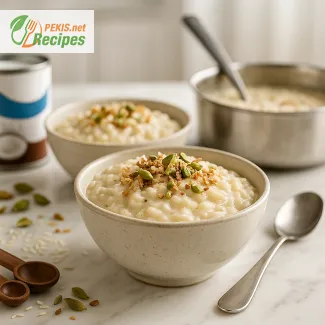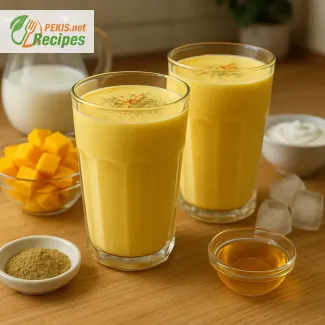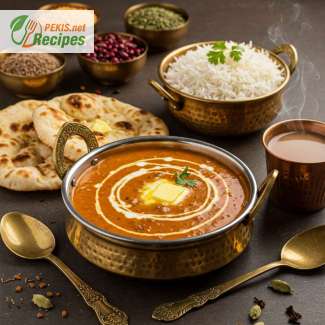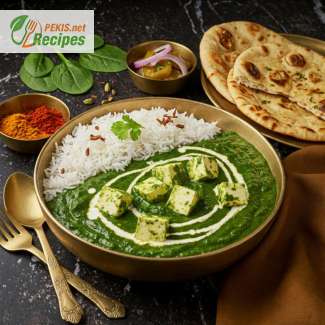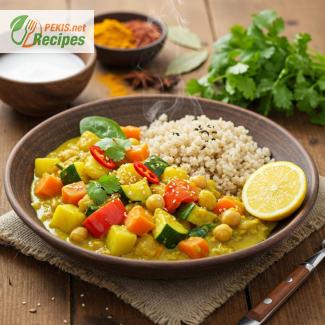
A Hearty and Nourishing Vegetable Curry with Whole-Grain Brown Rice
A Wholesome and Flavorful Dish for Every Occasion
Few dishes bring as much warmth, comfort, and richness of flavor as a well-prepared vegetable curry. This vibrant, spice-infused meal is packed with nutrients, offering a perfect balance of aromatic spices, fresh vegetables, and wholesome grains. When served with fluffy brown rice, it transforms into a nourishing and satisfying meal that appeals to both vegetarians and omnivores alike.
This vegetable curry with brown rice is an excellent option for anyone looking for a nutrient-dense, plant-based meal that is both delicious and fulfilling. The combination of slow-simmered vegetables, creamy coconut milk, and fragrant spices creates an irresistible depth of flavor, making it a perfect choice for a weeknight dinner, a meal prep staple, or even a special gathering.
The Essence of a Perfect Vegetable Curry
At the heart of this vegetable curry lies the perfect blend of spices, including turmeric, cumin, coriander, and garam masala. These ingredients not only enhance the taste but also provide a wealth of health benefits, known for their anti-inflammatory and digestive properties. The combination of fresh vegetables such as carrots, bell peppers, zucchini, and potatoes ensures a symphony of flavors and textures, making every bite a delightful experience.
Coconut milk adds a luxurious creaminess, balancing the heat of the spices while infusing the dish with a hint of natural sweetness. The slow cooking process allows the flavors to meld beautifully, creating a rich and deeply satisfying dish that only gets better with time.
Why Brown Rice is the Perfect Companion
Unlike white rice, brown rice retains its nutrient-rich bran layer, making it a fiber-packed and heart-healthy choice. It has a chewy texture and a slightly nutty flavor, which complements the bold and aromatic curry. The complex carbohydrates in brown rice provide long-lasting energy, while its high fiber content promotes digestion and satiety.
Cooking brown rice requires a bit more time than white rice, but the nutritional benefits and enhanced texture make it well worth the effort. When paired with a flavorful vegetable curry, it absorbs the savory sauce beautifully, creating a harmonious balance of taste and texture.
A Versatile Dish for Every Palate
One of the best things about vegetable curry is its versatility. You can easily customize the ingredients to match your personal preferences or use whatever vegetables you have on hand. Whether you prefer a mild and comforting version or a spicier and more intense variation, you can adjust the spice levels accordingly.
For added protein, consider incorporating chickpeas, lentils, or tofu, turning this dish into a complete, well-rounded meal. If you enjoy a bit of crunch, garnishing with toasted cashews or almonds can provide an extra layer of texture and richness.
Health Benefits of Vegetable Curry with Brown Rice
Beyond its delicious taste, this dish is packed with essential nutrients that promote overall well-being:
- Rich in Antioxidants – Spices like turmeric and cumin help combat inflammation and support immune health.
- High in Fiber – Brown rice and vegetables support digestion and keep you full longer.
- Balanced Macronutrients – The combination of healthy fats, plant-based protein, and complex carbs ensures sustained energy.
- Heart-Healthy Ingredients – Ingredients like garlic, onions, and coconut milk contribute to cardiovascular health.
Perfect for Meal Prep and Leftovers
This vegetable curry with brown rice is a fantastic meal prep option, as the flavors deepen over time, making it even more delicious the next day. It stores well in the refrigerator for up to four days, and it can also be frozen for future meals. The ease of reheating makes it a convenient choice for busy schedules, ensuring that you always have a nutritious, home-cooked meal ready to enjoy.
A Dish for Every Season
No matter the time of year, this vegetable curry remains a comforting and nourishing meal. In warmer months, you can enjoy it with lighter vegetables like zucchini, bell peppers, and green beans, while in colder seasons, you can incorporate heartier ingredients like sweet potatoes, squash, and lentils for a more warming experience.
Whether you're looking for a healthy weeknight dinner, a meal to impress your guests, or a satisfying and nutrient-rich dish, this vegetable curry with brown rice is the perfect choice. The combination of vibrant spices, wholesome vegetables, and hearty grains ensures that every bite is packed with flavor, nutrition, and comfort.
- Prepare the brown rice: In a saucepan, bring 500 ml (2 cups) of water to a boil. Add 200 g (1 cup) of brown rice and 1 g (¼ tsp) of salt. Reduce heat, cover, and simmer for 35-40 minutes until the rice is tender and the water is absorbed. Remove from heat and let it sit for 5 minutes, then fluff with a fork.
- Sauté the aromatics: In a large pot, heat 15 ml (1 tbsp) of olive oil over medium heat. Add 150 g (1 medium, diced) onion and sauté for 3-4 minutes until soft. Stir in 10 g (2 cloves, minced) garlic and 10 g (1 tbsp, grated) ginger, cooking for another 1 minute until fragrant.
- Cook the vegetables: Add 100 g (1 medium, sliced) carrot, 150 g (1 large, chopped) red bell pepper, 150 g (1 medium, chopped) zucchini, and 200 g (1 large, diced) potato. Sauté for 5 minutes, stirring occasionally.
- Add spices and liquids: Sprinkle 10 g (2 tsp) curry powder, 5 g (1 tsp) ground cumin, 5 g (1 tsp) ground coriander, 3 g (½ tsp) turmeric, 3 g (½ tsp) garam masala, 2 g (½ tsp) salt, and 1 g (¼ tsp) black pepper over the vegetables. Stir well to coat.
- Simmer the curry: Pour in 400 g (1 can, 14 oz) canned diced tomatoes, 400 ml (1 can, 14 oz) coconut milk, and 250 ml (1 cup) vegetable broth. Stir in 240 g (1 cup, drained and rinsed) chickpeas. Bring to a boil, then reduce heat and simmer uncovered for 20-25 minutes until the vegetables are tender and the sauce thickens.
- Final touches: Stir in 100 g (2 cups) fresh spinach and cook for 2 minutes until wilted. Remove from heat and mix in 10 ml (2 tsp) lemon juice.
- Serve: Divide the brown rice into bowls and ladle the vegetable curry on top. Garnish with 5 g (2 tbsp) chopped fresh cilantro.
Elevating the Classic Vegetable Curry with Brown Rice
Enhancing the Depth of Flavor with Simple Adjustments
A well-prepared vegetable curry with brown rice is already a delightful and nutritious meal, but there are ways to enhance its flavor, texture, and nutritional value even further. By carefully selecting and modifying ingredients, cooking techniques, and seasoning balance, you can transform this dish into an even more vibrant and satisfying experience.
From adjusting spice levels to improving texture and consistency, small tweaks can make a significant difference in how this dish is enjoyed. Additionally, homemade preparation ensures full control over the quality of ingredients and flavor balance, making it superior to pre-made or restaurant versions.
Key Ingredients That Can Elevate the Flavor
Roasting Spices for Enhanced Aromatics
One of the easiest ways to deepen the flavor of a vegetable curry is by toasting the spices before adding them to the dish. Dry-roasting cumin, coriander, turmeric, and garam masala in a dry pan for 1-2 minutes helps release their essential oils, intensifying their aroma and giving the curry a richer, more complex taste.
For an even more robust flavor, consider using whole spices such as cinnamon sticks, cardamom pods, and whole cloves, which can be lightly toasted before grinding or adding directly to the simmering curry.
Using Fresh Ingredients Instead of Processed Versions
Freshness plays a major role in the final taste of any dish. Using fresh tomatoes instead of canned, grating fresh turmeric and ginger, and opting for homemade vegetable broth instead of store-bought can make a noticeable difference in flavor clarity and depth.
For the coconut milk, selecting a high-quality, full-fat version ensures a creamier and more luxurious texture, while a homemade coconut milk (by blending fresh coconut with warm water and straining) offers an even more authentic and vibrant taste.
Adjusting the Texture for a More Satisfying Bite
Thickening the Curry Without Sacrificing Flavor
If you prefer a thicker and richer curry, there are several natural ways to achieve this:
- Blending a portion of the cooked vegetables with some broth before mixing them back into the pot creates a silky and creamy consistency.
- Adding mashed chickpeas helps naturally thicken the sauce while increasing the protein and fiber content.
- Using ground cashews or almond paste adds a nutty depth and makes the dish more indulgent without overpowering the spice blend.
Conversely, if you enjoy a lighter and more broth-based curry, simply increase the amount of vegetable broth or coconut milk while reducing the cooking time slightly to maintain the fresh flavors.
Achieving the Perfect Brown Rice Texture
The texture of brown rice can be improved significantly by using a soaking method. Soaking the rice in water for at least 30 minutes before cooking reduces cooking time and results in a fluffier, more even texture.
Additionally, cooking the rice using the absorption method (rather than draining excess water) allows the grains to fully absorb the flavors of any added ingredients, such as bay leaves, cloves, or star anise, making the rice more aromatic and flavorful.
Common Mistakes to Avoid
Overcooking the Vegetables
Vegetables should be tender yet firm, retaining some bite and texture. A common mistake is overcooking them, which leads to mushy or bland results. To prevent this:
- Add harder vegetables like potatoes and carrots first, as they take longer to cook.
- Introduce softer vegetables like zucchini and bell peppers towards the end of cooking to preserve their natural sweetness and crunch.
Skipping the Tempering Process
Many home cooks miss the step of tempering the spices properly, which is essential for unlocking their full aromatic potential. Instead of adding spices directly to the curry liquid, they should be briefly sautéed in oil with onions and garlic to ensure their flavors develop fully.
Using Low-Quality Rice
Since brown rice is an integral part of the dish, choosing a high-quality, aromatic variety such as Basmati or Jasmine brown rice enhances the overall dining experience. Avoid rice that has been stored for too long, as older grains may cook unevenly or develop an unpleasantly firm texture.
Healthier Alternatives Without Compromising Flavor
Lowering the Fat Content
While coconut milk contributes to the creamy texture of the curry, those looking to reduce saturated fat can substitute light coconut milk, blended silken tofu, or a mix of almond milk and cornstarch for a similar texture with fewer calories.
Increasing the Protein Content
To make this dish more protein-rich, consider adding:
- Lentils or split peas for a thicker, heartier curry.
- Tofu or tempeh, which absorb the flavors of the curry well.
- Quinoa instead of brown rice, offering a complete protein source with a lighter texture.
The Benefits of Homemade Curry Over Store-Bought Versions
Control Over Ingredients and Sodium Levels
Many pre-packaged curry pastes and restaurant versions contain excessive sodium, artificial preservatives, and added sugars. By making vegetable curry from scratch, you can control the salt content, avoid unnecessary additives, and use fresh, wholesome ingredients.
Customizing the Spice Level
A homemade curry allows for full control over spice intensity. Whether you prefer a milder dish or a spicier version, adjusting the amount of chili powder, cayenne, or fresh chilies ensures the heat level matches personal preferences.
Improving a vegetable curry with brown rice is all about understanding the balance of flavors, textures, and cooking techniques. By enhancing spices, optimizing the vegetable cooking process, and incorporating healthier ingredients, this dish can be made even more delicious, satisfying, and nutritious.
Making the curry at home not only ensures better quality and customization but also provides a chance to experiment with different flavors and textures, making each version a unique and personal creation.
- This recipe contains coconut (from coconut milk), which may be an allergen for some.
- It is gluten-free, making it suitable for those with gluten intolerance or celiac disease.
- For a nut-free version, ensure coconut milk is safe for the individual consuming it.
Substitutions for Allergens and Gluten-Free Diet:
- Coconut-free option: Replace coconut milk with cashew cream or dairy-free oat milk for a similar creamy texture.
- Soy-free alternative: Ensure vegetable broth is soy-free or replace it with homemade broth.
- Vitamin A: 120% DV (important for vision and immune health)
- Vitamin C: 80% DV (boosts immune function and supports skin health)
- Iron: 4 mg (22% DV, essential for oxygen transport in blood)
- Potassium: 800 mg (important for muscle function and heart health)
- Calcium: 90 mg (supports bone strength and muscle function)
- Turmeric (Curcumin): 200 mg (potent anti-inflammatory and supports brain health)
- Vitamin C: 70 mg (powerful antioxidant for cell protection)
- Beta-Carotene (from carrots): 4 mg (supports eye health and immune system)
This vegetable curry with brown rice is a nutritious, flavorful, and wholesome meal, perfect for any occasion!
